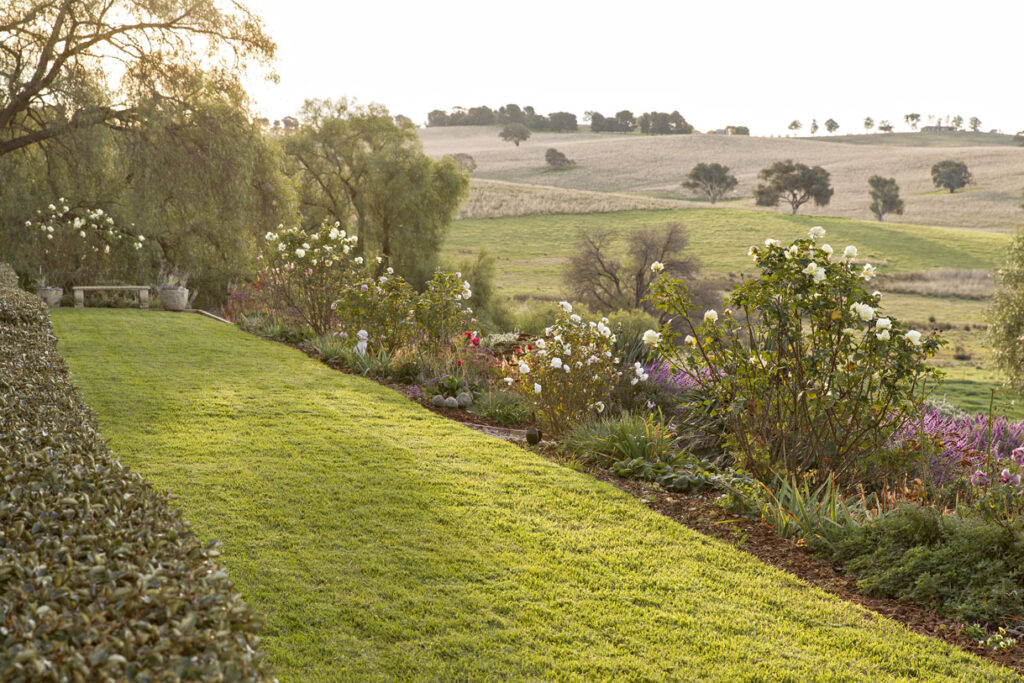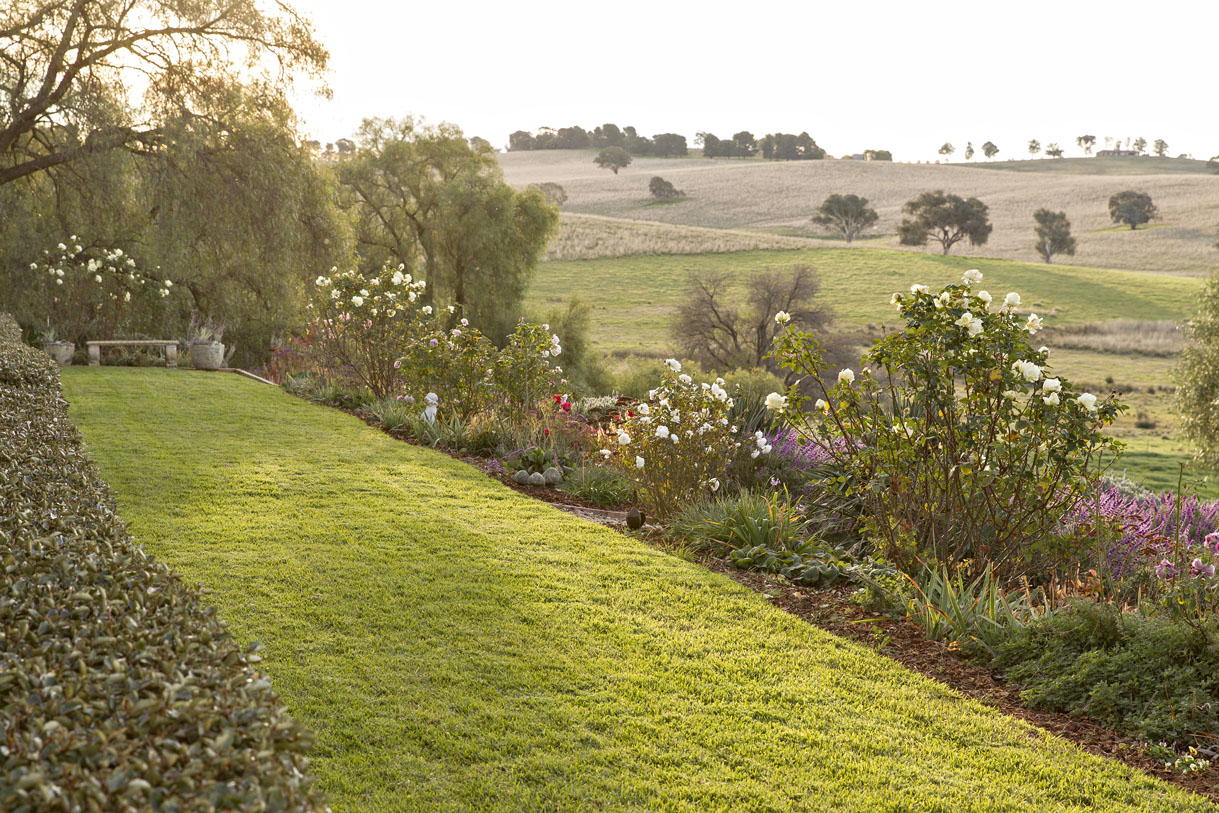Escaping the city for a tree change
By Glenice Buck –
Escaping the city for a tree change sounds easy enough but relocating an established horticultural business requires forward planning and a bit of effort to avoid a catastrophic disruption in your income stream. If you are thinking of making this change yourself, here are a few first-hand tips on how to make the change run smoothly.
I am often asked how or why we made the decision to move from the city to the country. My husband (fiancé at the time) and I, on one sunny summer Sunday afternoon were having a deep and meaningful conversation about our future life together. At the time we were living in Sydney. After some discussion, we both realised that we saw ourselves living somewhere in a rural area. Within two months of this conversation, we had made the move to Young, NSW. Young was chosen as my brother and his family, as well as my parents, were based in that area. It just made sense.

Glenice presenting a workshop at Jane Costello’s Garden – the Rustic Maze and Country Garden, Monteagle, NSW
Fortunately, my husband Phillip was able to get employment quite quickly. I then had the task of relocating my ten-year-old horticultural business from the urban area to rural area. I had decided that I would still travel back to Sydney for my regular garden maintenance work, tree, and design work once every 2 to 3 weeks. This lasted for 12 months and it was fantastic for cash flow in the short term as we transitioned the business, but it was not sustainable in the long term.
I really started to feel that whilst I lived in the country, all my time was being spent and focused on either driving to or being in the city. I had to let go of my maintenance business, however, I continue to do the consultancy work as I can work these in over longer time frames. In the meantime, I was really trying to get to know the horticulture industry in the region.
Soon after we moved to Young, a local businessperson gave me two pieces of good advice about working in the country compared to working in the city – he said “You need to make work for yourself in the country. The work is there but you need to create the opportunity for yourself. It won’t just fall in your lap you have to find it.” He also said “You will notice when the season is good, the farmers and the rest of the community will spend money on their gardens. When the season is in drought, you need to be able to offer another avenue or way to develop your business.” This last comment has really been proven to be correct, as in the last 12 months the drought has broken and along with that has come more regular business.
Getting to know to get to know the local businesses in my industry was important so I started a program of networking. I used several different methods to try and make contacts in the hope of gaining work. The methods were:
- Reaching out to other horticultural businesses in the area – landscapers, nurseries, and designers. Everyone was really welcoming and friendly. These connections proved valuable as I still get work referred to me from these contacts.
- Making phone calls and following up with emails to related businesses (builders, architects, arboricultural companies) that were situated within a two-hour radius of Young. When you live in the country you really must be prepared to travel! However, after commuting in Sydney’s morning traffic for years, it is not hard to drive two hours on a country road.
- Placing an advertisement in the local paper – they have a fabulous arrangement where if you purchase an advertisement, they will give you column space to write an article. I developed a monthly garden column which still runs today and has a good following. This has been valuable in many ways. Firstly, it is marketing my business, I am demonstrating my expertise and has also given me good copy to use on my blog and in my monthly newsletter.
- Offering my services by presenting talks to local garden groups. This is a volunteer type arrangement, but it has raised my profile. It again, gives me good content to use in my monthly newsletter, blog, and social media platforms.
- Developed and deliver garden workshops at the local nursery. This proved to be an extraordinarily successful marketing tool therefore I have continued doing this from our home office as well as out at the garden I have created on my parent’s farm. Quite surprisingly, these workshops provided priceless advertising for my business and people really gained interest in my work. The workshops bring together like-minded people in one room and always run over time as there is so much interest.
- In the last six months I have made a conscious effort to focus on increasing my social media presence. As much as it is not my favourite thing to do, I think this increase in regular posting has led to more opportunities and has been a good medium for advertising my workshops.
- Building on my database from all my workshops (pre-COVID-19 times) by collecting people’s email addresses so I could build my newsletter subscribers list. Developing the monthly newsletter is a great way to stay in touch with clients. If one day, any of your social media pages collapses, having your email list of contacts is a great backup.

If you are considering moving away to a new area be sure to maintain existing relationships with colleagues and contacts in the city. There are always times when you may need advice or recommendations. If you lose those formed relationships, it can be hard to rebuild. I found by continuing my membership of industry bodies such as AILDM, IACA and the HMA, it helped to stay on top of industry news and keep up to date. Most conferences and meetings can be accessed online, especially now in times of a pandemic. This brings people interstate and overseas much closer to each other. All these actions really worked together to increase my profile and help spread the word that I was working in the region. In the last two months, my husband has joined my business. We are now able to provide garden maintenance and soft landscaping service to clients. These added services mean we can cover all levels of landscaping, other than structural work. Building a profile again for our business has been a slow process but building it was so important because once you have the identity, word of mouth will take on its own momentum and work will develop.
Glenice Buck is a Landscape Designer, Horticulturist, Consultant Arborist and Freelance Garden Writer. Her business, Glenice Buck Designs is based in Young, NSW. She is a Member of Institute of Australian Consulting Arboriculturists (IACA), Member and Fellow of Australian Institute of Landscape Designers and Managers (AILDM) and a Member of the Horticultural Media Association (HMA). Subscribe to a FREE Garden Newsletter or download Glenice’s first e-book for free “An Introduction to Your Garden – How to Learn the Art of Gardening” via my website
www.glenicebuckdesigns.com.au
E: glenice@glenicebuckdesigns.com.au
M: 041 7077 386.
Instagram and Facebook as glenice_buck_designs

